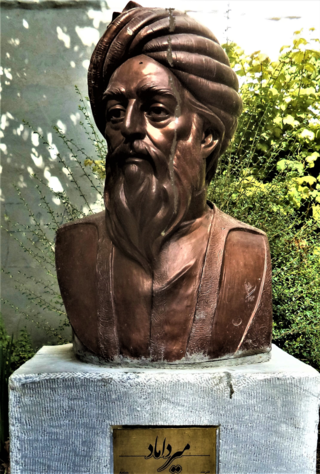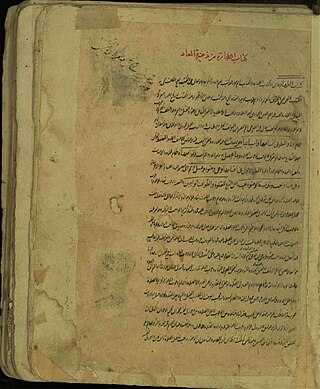
Mohammad-Ali Mirza Dowlatshah was a famous Iranian Prince of the Qajar dynasty. He is also the progenitor of the Dowlatshahi Family of Persia. He was born at Nava, in Mazandaran, a Caspian province in the north of Iran. He was the first son of Fath-Ali Shah, the second Qajar king of Persia, and Ziba Chehr Khanoum, a Georgian girl of the Tsikarashvili family. He was also the elder brother of Abbas Mirza. Dowlatshah was the governor of Fars at age 9, Qazvin and Gilan at age 11, Khuzestan and Lorestan at age 16, and Kermanshah at age 19.

Mir Damad, known also as Mir Mohammad Baqer Esterabadi, or Asterabadi, was a Twelver Shia Iranian philosopher in the Neoplatonizing Islamic Peripatetic traditions of Avicenna. He also was a Suhrawardi, a scholar of the traditional Islamic sciences, and foremost figure of the cultural renaissance of Iran undertaken under the Safavid dynasty. He was also the central founder of the School of Isfahan, noted by his students and admirers as the Third Teacher after Aristotle and al-Farabi.
Gholhak is a neighborhood located in District 3 of Tehran Municipality. It is bounded on the east by the Darrous neighborhood, on the west by the Gholhak River, on the north by the British Embassy Garden, and on the south by the Pourmeshkani Street and Zafar Street (Dastgerdi).

Grand Ayatollah Mohammad-Reza Golpaygani was an Iranian Shia Muslim and marja' scholar. He was born in 1899 in Gogad village near the city of Golpaygan, Iran. He was taught preliminary studies by his father, Mohammad Bagher. At the age of 9, his father died and later on moved to Golpaygan to continue his studies. He was one of the highest-ranking Islamic clergies to participate in the Iranian Revolution, and a one-time serious contender to succeed Ruhollah Khomeini in the 1989 Iranian Supreme Leader election. However, his candidacy was voted down by the Assembly of Experts, in favor of the eventual successor, Ali Khamenei.
Sayyid Ahmad Musavi Hindi was a Twelver Shia cleric. He was the paternal grandfather of the supreme leader of the Islamic republic of Iran, Ruhollah Khomeini.

Seyyed Nematollah Jazayeri was a prominent Shia scholar born in 1640 and died in 1700, in one of the islands around Basra. He was one of the grandchildren of Musa al-Kadhim. His paternal lineage is as follows: Seyyed Ne'mat Allah son of Seyyed Abd Allah son of Mohammad son of Hossein son of Ahmad son of Mahmoud son of Ghias Aldin son of Majd Aldin son of Noor Aldin son of Saad Allah son of Issa son of Musa son of Abdallah son of Musa al-Kadhim.

Sheikh Jafar ibn Hussein ibn Ali Shooshtari was a prominent Shia scholar from the city of Shooshtar.
Chamaz Koti (Persian: چمازكتي, also Romanized as Chemāz Ketī and Chamāz Katī; is a village in Nowkand Kola Rural District of the Central District of Qaem Shahr County, Mazandaran province, Iran.
Mirza Sayyed Hasan was a Safavid prince. He was the son of the high-ranking Iranian statesman Khalifeh Sultan, and the Safavid princess Khan-Agha Begum. In 1632, Mirza Sayyed, together with the rest of his three brothers, were blinded by Shah Safi, who feared that his place was in danger from other Safavid royal members. Because of this, Mirza Sayyed was not able to occupy any post. He did, however, become one of the most dominant ulama of his time. At an unknown date, he married the Safavid princess Zobeydeh Khanum, who was the daughter of Shah Suleiman I, and the sister of the later Shah Sultan Husayn. Hasan and Khanum werer the parents of Mirza Mohammad Baqer and Mir Sayyed Morteza, who both served as the sadr-i khasseh and sadr-i mamalik under their cousin Sultan Husayn.

Seyyed Ali Shafiei is an Iranian Twelver Shia scholar, who is a member of Assembly of Experts from Khuzestan province. He is a/the son of Seyyed Mohammad Reza (Shafiei) who was from the known Islamic scholars of Khuzestan. Seyyed Ali Shafiei commenced his educations from Maktabkhaneh (Kuttab), and began to peruse Quran and Islamic issues. Afterwards, he entered a new school. Later on, he went to educate Hawzah lessons in the city of Ahwaz. Then, Seyyed-Ali departed to the Seminary of Najaf, in Iraq. After Najaf, he came back to Ahwaz; and was appointed as a/the Imam of Jama'ah in Ahwaz, and commenced to promote Islamic rulings.
Abu'l-Fath Khan Javanshir was an Iranian commander who participated in the Russo-Iranian War of 1804–1813. He was the son of Ibrahim Khalil Khan, a member of the Javanshir tribe and governor of the Karabakh Khanate in the South Caucasus.

Mohammad Hassan Rahimian is an Iranian Twelver Shia cleric, who has been appointed as the trusteeship of Jamkaran Mosque since 2013 till now --by the decree of supreme leader of Iran, Seyyed Ali Khamenei. Rahimian is the head of the Central-Council of Popular Front of Islamic Revolution Forces, and the administrative board of the Front of Islamic Revolution Stability.

Seyyed Mohammad Hojjat Kooh Kamari was a contemporary Iranian Muslim Faqīh and a Twelver Marja' who was in charge of the administration of the Qom Seminary for ten years. He was born on 17 March 1893 and died on 19 January 1953. He was a prominent student of Abdul-Karim Haeri Yazdi and after him held the position of Shia authority.
Mirza Abolghasem Gilani, known as Mirza-ye Qomi, the author of the book of Qawanin al-Usul, was a Shiite jurist (Faqīh), mujtahid, fundamentalist (Usuli) and a religious reference (Marja') during the reign of Fath Ali Shah Qajar in the twelfth century AH. Mirza-ye Qomi was active and famous in poetry and calligraphy. He has left more than fifty thousand verses of poetry in Persian and Arabic, as well as writings in Naskh and Nastaliq scripts.

The Isfahan Seminary is one of the oldest seminaries in Isfahan, Iran. Currently, more than 40 schools in Isfahan province are under the supervision of the Management Center of Isfahan Seminary and the leadership of the supreme authority of Grand Ayatollah Hossein Mazaheri.

Agha Hossein Khansari, full name Hossein ibn Jamal al-Din Mohammad Khansari, known as Mohaghegh Khansari and also known as "Master of all in all", who was nicknamed "the disciple of mankind" because of the many masters he acquired knowledge in their presence, was one of the great Iranian jurists of Isfahan jurisprudential school in the 11th century AH, who was also engaged in philosophy and wisdom. He was one of the high level scholars during the reign of Sultan Suleiman of the Safavid dynasty and after the death of Mir Seyyed Mohammad Masoom in 1683, he became the Shaykh al-Islām of Isfahan. His children are Jamaluddin Mohammad known as Agha Jamal Khansari and Raziauddin Mohammad known as Agha Razi Khansari.

Mullah Mohammad Jafar Sabzevari was one of the Iranian scholars and clerics of the 12th century AH, the Imam of Friday Prayer of the Shah Mosque in Isfahan and the author of several books and treatises including "Nowruznameh" and "Ma'ad" which was compiled at the request of Shah Sultan Hussein Safavid.

Mohammad Bagher Sabzevari known as Mohaghegh Sabzevari was an Iranian Faqih and Shiite scholar from the 11th century AH, Shaykh al-Islām and the Imam of Friday Prayer of Isfahan.

Mohammad Hossein Esheni or Mohammad Hossein Esheni Qudejani was an Iranian Shia cleric and experienced Faqih.





























